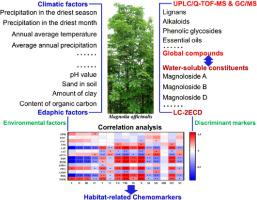Phytomedicine ( IF 6.7 ) Pub Date : 2022-01-29 , DOI: 10.1016/j.phymed.2022.153957 Zhenzhen Xue 1 , Xiaobo Zhang 2 , Huasheng Peng 2 , Shoudong Zhu 2 , Jinwen You 3 , Tao Zhou 4 , Liying Yu 5 , Chuan Song 6 , Bin Yang 6

|
Background
The quality of traditional Chinese medicines (TCMs) has been closely related to their growth regions. The geo-herbalism of TCMs is just like the protected destination of origin on foodstuffs and wines, telling us the specific geographic regions could yield TCMs with superior quality. However, the impact of habitat on TCMs could hardly been indicated in current quality evaluation, defects were as follows: (1) few studies involved the effect of environmental factors, (2) more attentions were paid to several abundant compounds, while global components especially water-soluble compounds were prone to be ignored.
Purpose
A new integrated metabolomics analysis based on global and water-soluble components was proposed aiming to explore habitat-related chemomarkers for TCMs combined with correlation analysis to environmental factors. The geo-herbalism of Magnoliae officinalis cortex (MOC) was studied as an example.
Methods
Multi-metabolomics approach based on UPLC/Q-TOF-MS and GC-MS combined with LC-2ECD were employed to analyze global components and accurately quantified water-soluble compounds, respectively. Meanwhile, decision tree, partial least squares discriminant analysis (PLS-DA) as well as hierarchical clustering analysis (HCA) heat map was applied to classify different samples and explore habitat-related chemomarkers. In addition, support vector machines model was used to verify the importance of screened out chemomarkers in predicting sample classification, and the impact of environmental factors on the markers were also demonstrated by correlation analysis.
Results
By analyzing 148 batches of MOC samples from 21 habitats, 238 variables were picked and 84 of them were identified by UNIFI, meanwhile, seven water-soluble compounds were accurately quantified. Among them, thirteen markers including Var.1, magnolignan E, magnoloside N isomer, α-agarofuran, γ-eudesmol, β-eudesmol, magnolosides A, B, D, F, H, L and M were suggested importance in grouping Chuan-po and the other MOC samples. Support vector machines model also indicated well prediction performance with an accuracy of 96.97%. Most markers belong to water-soluble compounds and temperature and precipitation contributed to such chemical differences.
Conclusions
The proposed strategy based on multi-metabolomics analysis could aid exploration of habitat-related chemomarkers for TCMs. Meanwhile, the screened out water-soluble compounds could perform equivalent functions in recognition of Daodi medicinal materials (DMMs) and non-DMM samples compared to the global components to some extent.
中文翻译:

应用全局和水溶性成分代谢组学方法探索厚朴皮质生境相关化学标志物
背景
中药的质量与其产地密切相关。中药的地本草学就像食品和酒类中受保护的原产地一样,告诉我们特定的地理区域可以生产出品质优良的中药。然而,目前的质量评价很难体现生境对中药的影响,存在以下缺陷:(1)很少有研究涉及环境因素的影响;(2)更多关注的是几种丰富的化合物,而全球成分尤其重要。水溶性化合物很容易被忽视。
目的
提出了一种基于整体和水溶性成分的新的综合代谢组学分析,旨在结合环境因素的相关分析来探索中药的栖息地相关化学标志物。以厚朴(MOC)的地草药学为例进行了研究。
方法
基于UPLC/Q-TOF-MS和GC-MS结合LC-2ECD的多代谢组学方法分别用于分析整体成分和准确定量水溶性化合物。同时,应用决策树、偏最小二乘判别分析(PLS-DA)以及层次聚类分析(HCA)热图对不同样本进行分类并探索与栖息地相关的化学标志物。此外,利用支持向量机模型验证了筛选出的化学标记物在预测样本分类中的重要性,并通过相关分析证明了环境因素对标记物的影响。
结果
通过对来自21个生境的148批MOC样品进行分析,筛选出238个变量,其中84个变量经UNIFI鉴定,同时对7种水溶性化合物进行了准确定量。其中,包括 Var.1、木脂素 E、木兰苷 N 异构体、α-沉香呋喃、γ-桉树醇、β-桉树醇、木兰苷 A、B、D、F、H、L 和 M 在内的 13 个标记在川组分组中具有重要意义。po和其他 MOC 样本。支持向量机模型也显示出良好的预测性能,准确率为 96.97%。大多数标记物属于水溶性化合物,温度和降水导致了这种化学差异。
结论
所提出的基于多代谢组学分析的策略可以帮助探索中药的栖息地相关化学标记物。同时,筛选出的水溶性化合物在识别道地药材(DMM)和非DMM样品方面与整体成分在一定程度上具有相当的功能。

































 京公网安备 11010802027423号
京公网安备 11010802027423号